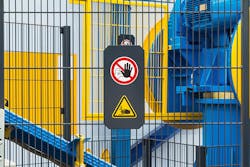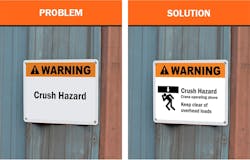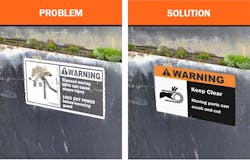Avoid These Common Safety Sign Mistakes
Safety signs are an essential part of any workplace safety program. They draw attention to important information, remind workers about hazards, and help prevent unsafe behavior. However, some common mistakes can make signs less effective or even cause them to be ignored completely. Mistakes include placing signs in the wrong place, using vague messages, and failing to maintain signs.
In the Wrong Place
PROBLEM
A sign that warns of a hazard too soon may be overlooked or ignored completely because workers can’t yet perceive the hazard. Each time workers see a safety sign, they perform an internal risk assessment to determine if they should comply with the sign’s message. If the hazard isn’t apparent in the environment, workers are less likely to comply with the sign.
Another problem occurs when signs are placed too close to the hazard or can’t be seen from a normal point of view. In both cases, these signs are unlikely to be seen, or if they are seen, it may be too late for workers to comply with the warning. (Source: “Safety Hierarchy: Design Vs. Warnings.” Visual Expert.)
SOLUTION
Safety signs should be placed where they can be seen and where they are needed. While there isn’t an absolute formula for this, there are some general rules that can help, which includes:
- Placing signs at safe viewing distance from the hazard
- Ensuring signs can be seen from the normal point of approach
- Ensuring placement gives workers enough time to respond to the sign before they encounter the hazard
- Ensuring signs are not obstructed and can be seen in low-light conditions by using lighting and reflective tape products as needed
Vague Messages
PROBLEM
Another common mistake occurs when safety signs don’t clearly communicate their intended message. Messages may be vague or use jargon that may not be widely understood. Dr. Green explains that the effectiveness of the warning depends largely upon the knowledge and experience of each viewer. (Source: “The Psychology of Warnings.” Visual Expert.)
A sign, for example, that reads “Warning: Crush Hazard” is vague. It requires viewers to have prerequisite knowledge of the required action and the exact consequence: What exactly gets crushed and how do you avoid being hurt?
If the sign is located on a loading dock, workers will likely interpret the sign differently. One might interpret the sign as a warning about overhead loads, which could fall and crush workers. Another employee might read the sign as a warning about being caught between a truck and another object. Both hazards exist, but the sign relies on the knowledge of each worker to complete the message. Which hazard is it referring to? (Source: “Safety Hierarchy: Design Vs. Warnings.” Visual Expert.)
SOLUTION
To create an effective message, make sure it communicates essential information that can be widely understood. This can be done by following some simple guidelines. These guidelines include:
- Clearly stating the required action (“Keep Clear,” “Do Not Operate,” etc.)
- Using precise language to communicate the source of the hazard (what does the crushing?)
- Using an image to help communicate the hazard (what gets crushed?)
Each of these elements will help bridge the knowledge gap and create a clear understanding of the hazard, its source, and how to stay safe. You can be sure your safety signs will effectively keep your workers safe.
Lack of Maintenance
PROBLEM
All too often, signs are put up and then forgotten. This leads to faded, obstructed, and outdated signs. At best, signs become difficult to read. At worst, signs cannot be read or provide inaccurate information. One common mistake revolves around electrical safety signs. When equipment is updated, voltages may change, altering arc flash and other hazards. A panel that once required category two personal protective equipment (PPE) may require category four PPE after the update. The outdated sign will mislead electricians, putting them in danger.
SOLUTION
Workplace safety can be improved by properly maintaining your facility’s safety signs. Make sign maintenance part of your safety program by:
- Replacing worn or damaged safety signs
- Moving signs that have become obstructed by equipment or other items
- Updating safety signs when systems are changed or new hazards are identified
These simple steps will eliminate safety issues caused by poorly maintained signs and help keep workers safe by providing clear, accurate information.
Safety Sign Solutions
Take workplace safety to the next level by making sure you have identified and labeled all workplace hazards. Reduce accidents and improve safety with the Best Practice Guide to OSHA Safety Signs by Graphic Products. This helpful guide walks you through the different types of safety signs, how to comply with OSHA’s requirements, and how to identify hazards in the workplace.
Create robust, OSHA-compliant signs in just a few minutes using a DuraLabel industrial label and sign printer by Graphic Products. Print vivid safety signs, both large and small, that will last and be seen when needed most. When signs need to be updated, quickly create new signs with messages tailored to your workplace.



